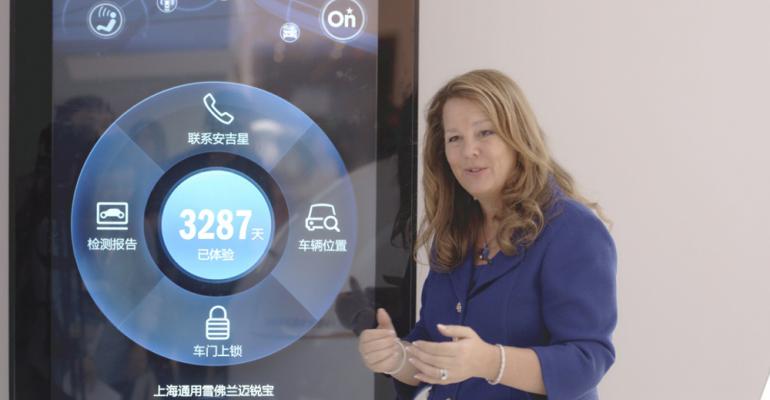BEIJING – Shanghai OnStar, GM China’s telematics unit, touted improved voice recognition, a new vehicle-theft alert and the next generation of its OnStar mobile application at the Beijing auto show in late April.
Introduced in June 2011, the enhanced app had 230,000 subscribers as of March 31, GM says. OnStar was launched in China in 2009 as a system embedded within a car’s electronics.
The automaker’s move to mobile communications was necessary to keep pace with China’s demanding drivers, says Diane Jurgens, managing director-Shanghai OnStar.
China is a latecomer to private car ownership. The vehicle market, now the world’s largest, only took off in 2002 after the country joined the World Trade Organization. The move to connected cars is coming even faster as automakers and suppliers rush to introduce their products and tailor them to China’s specific needs.
“The Chinese consumers come from a background of more connectivity, so a connected car is expected,” says Thilo Koslowski, vice president-smart mobility at market researcher Gartner. “In the next six to eight years, the growth of connected vehicles in China will be the fastest in the world.”
The numbers tell you why. Nearly 12 million cars were sold in China in 2013, up 12% from the previous year, according to WardsAuto data. Smartphone ownership is also skyrocketing. According to Forrester Research, in 2014 China’s installed-smartphone base will top 500 million, more than the U.S. and Western Europe combined.
Just as many Chinese have bypassed fixed phone-line ownership and gone straight to a mobile phone, automakers in China are bypassing embedded telematics systems and starting out with equipment that allows the mobile phone to connect the car to the cloud. And connectivity isn’t limited to luxury models; Chinese at all income levels want better interfaces, more services and more data.
“Everyone has a digital lifestyle,” Koslowski says.
Chinese automakers BYD, SAIC, Qoros and Changan all offer connectivity in their models, says Kevin Huang, an analyst with Ways Consulting in Guangzhou. “As a Chinese customer, I want a car that can get access to the Internet easily by (a mobile phone) connection,” he says.
That calls for low-priced but high-quality products that present both a challenge and an opportunity for suppliers. Harman sells the head unit for automotive audio and infotainment systems and is growing quickly in China, where it has invested more than $100 million over the past five years.
More than 70% of its current customers are in the luxury segment, says Tong Zhao, vice president and general manager-infotainment for Harman in China. But with infotainment becoming standard in mid- and low-end models, the electronics manufacturer is looking to make its platform scalable.
“We want to use it for a more cost-effective solution, to drop down the price,” he says.
Bosch introduced its mySPIN smartphone integration system to China at the Beijing show. It works with Apple or Android phones and, priced below €100 ($138) for the display system and software, mySPIN should appeal to price-conscious Chinese consumers, says David Xu, executive vice president-Bosch China. “A lot of OEMs are talking with us,” he says.
Demand for connected-car products is developing so quickly in China that all the component suppliers are challenged to keep up, Xu says, adding, “We have to develop at a faster mode.”
Automakers also must offer connected-car applications that Chinese consumers want. Importing foreign products isn’t sufficient because many of them are country-specific or not accessible, points out Joe Xia, manager-AppLink and Advanced Product Development at Ford Asia Pacific. AppLink allows hands-free use of smartphones in a car.
Google is blocked in China and music apps Spotify and Pandora aren’t popular in China. But, Xia points out, “A lot of apps in China do exactly the same thing.”
Ford China has turned to local developers for product offerings on its SYNC AppLink system. “Right now, Ford is making a concerted push to the developer community to make their apps compatible with AppLink,” he says.
Ford announced at the Consumer Electronics Show in January it has partnered with Chinese Internet firm Tencent’s QQ Music, one of China’s largest online streaming-music platforms. It now works with eight Chinese companies to offer 12 apps, says Xia.
GM’s OnStar China has made other changes to appeal to the local market. In the U.S. it offers only two service packages. In China, it offers five packages ranging in price from the equivalent of $79 to $253.
“That’s a result of our market surveys and understanding of Chinese consumers,” says Jurgens.





